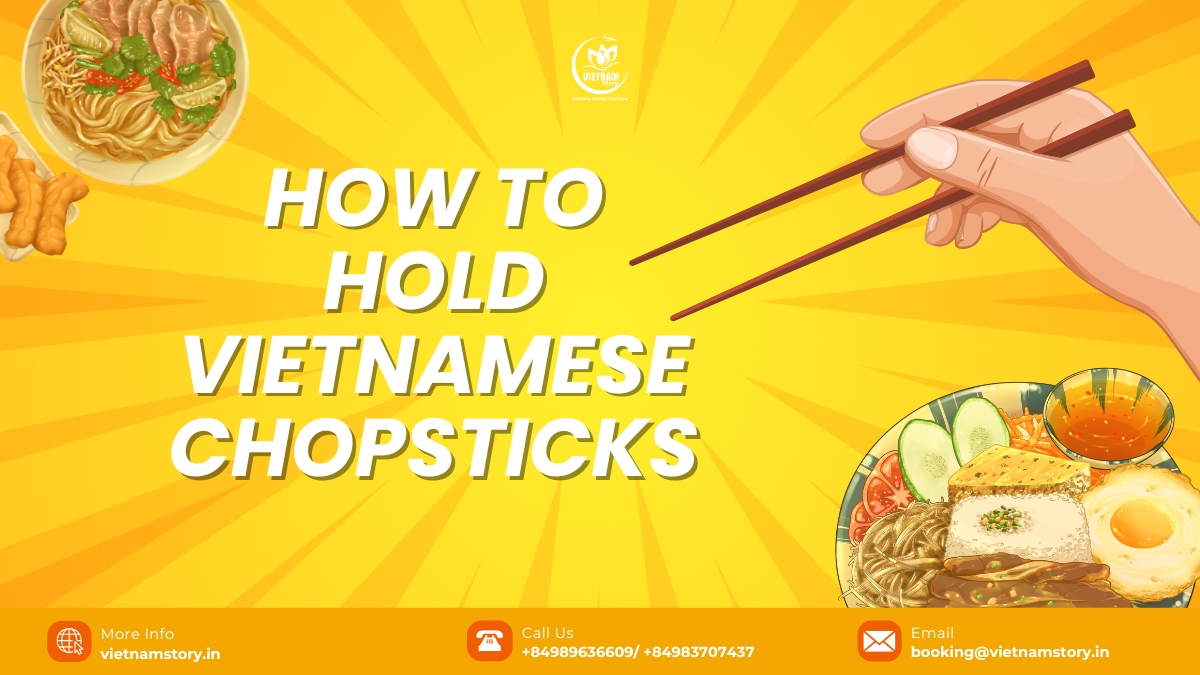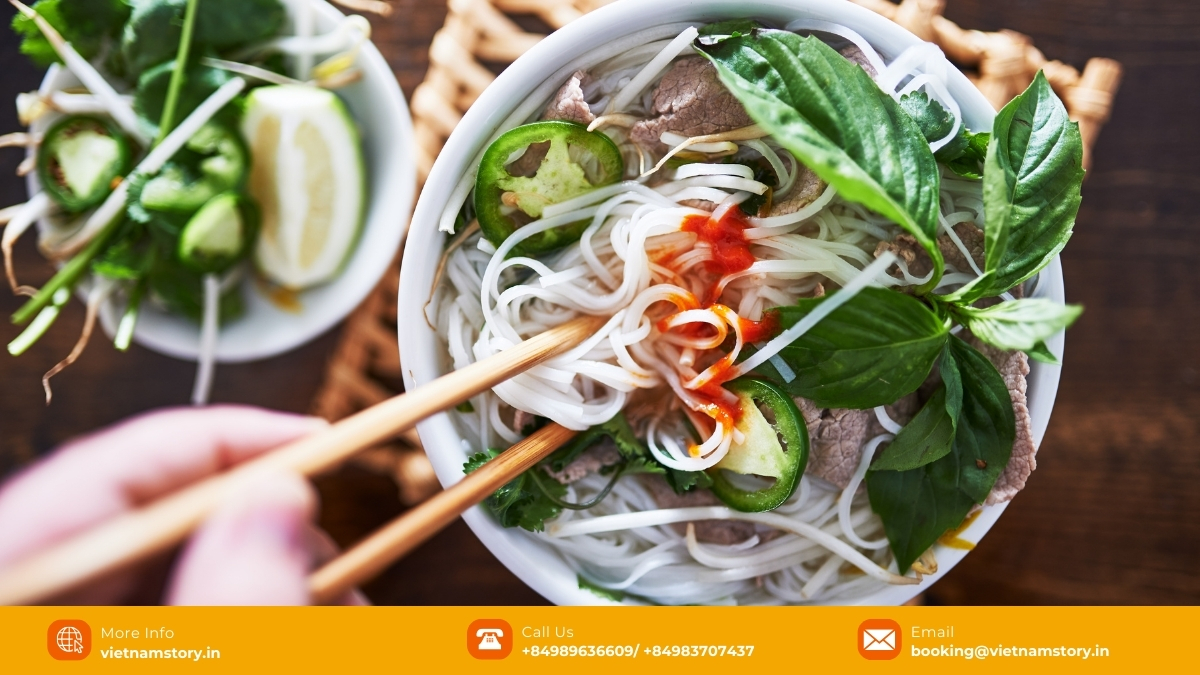Learning how to hold chopsticks is the first step to fully enjoying Vietnamese cuisine — and for many Indian visitors, it’s a fun and fascinating cultural experience. Chopsticks, those slender, elegant eating utensils, are fundamental to dining culture across Asia, and Vietnam is no exception. While they might seem tricky at first, mastering the proper chopstick grip enhances your dining experience and shows respect for local customs. This guide provides clear, step-by-step instructions on using chopsticks, techniques for eating different foods, and essential Vietnamese dining etiquette.

Understanding Chopsticks: Materials and Types
Before diving into the technique, it helps to know the tools. Chopsticks vary:
- Material: Commonly made from bamboo or wood, which are excellent for beginners due to their natural grip. You’ll also find plastic, elegant lacquered chopsticks (common in Japan), and sleek metal or stainless steel chopsticks (traditional in Korea), which can be more slippery and challenging for novices.
- Disposable Chopsticks (Waribashi): Often made of wood or bamboo and joined at the top, these are common in restaurants for hygiene. Simply snap them apart. Avoid rubbing them together vigorously in public, as it can imply the restaurant uses cheap, splintery quality (though discreetly removing a splinter under the table is acceptable).
- Reusable Chopsticks: Made from durable materials, these are common in homes and more formal settings.
For your first attempts, using wooden or bamboo chopsticks is highly recommended as they provide the easiest grip.
READ MORE: A Culinary Tapestry: Embracing The Flavors Of Vietnam
How to Hold Chopsticks: The Step-by-Step Guide
The secret lies in keeping one chopstick stationary while manipulating the other. Here’s the most widely accepted method focusing on core elements like Grip Style, Finger Placement, Stability, and Movement Control:
- Position the Bottom (Anchor) Chopstick: This chopstick remains stationary. Let the thicker end rest securely in the crook of your thumb (the space where your thumb and index finger connect). The middle part of this chopstick should rest firmly against the side or top of your ring finger. Your thumb should lay gently over it, helping to keep it stable. This provides the crucial stability.
Value Check: Bottom Chopstick – Position – Rests on ring finger & crook of thumb; Movement – Stationary.
- Position the Top (Moving) Chopstick: Hold this chopstick much like you would hold a pen or pencil. It should rest lightly against the side of your middle finger (around the top knuckle) and be guided by the tips of your index finger and thumb. Keep your thumb relatively straight. This top chopstick is the only one that should move. This focuses on Movement Control.
Value Check: Top Chopstick – Position – Held like a pen with index, middle finger, thumb; Movement – Moves up and down.
- Refine Your Grip: Ensure you are holding the chopsticks about one-third of the way down from the thicker ends (the upper third), not in the middle. This gives better leverage. Check that the tips align evenly – you can gently tap them on the table to level them if needed. The Grip Style should be relaxed but firm enough for control.
Value Check: Grip – Location – Upper third of the chopstick.
- Practice the Movement: Keeping the bottom chopstick perfectly still, use your index and middle fingers to pivot the top chopstick up and down. Practice opening the tips apart and bringing them together smoothly. Aim to touch just the tips together repeatedly. This develops Pressure Application control – gentle enough not to crush food, firm enough to hold it. Avoid crossing the tips.
Value Check: Top Chopstick – Control – Index and middle fingers.
Remember, there are slight variations, and comfort is key. If the described method feels awkward, minor adjustments are okay, as long as the bottom stick stays stable and the top one moves freely.

Putting it into Practice: Picking Up Food
Once you have the basic chopstick grip:
- Approach the food at a comfortable angle (around 45 degrees often works well).
- Open the top chopstick using your index and middle fingers.
- Position the tips around the piece of food you want to pick up.
- Gently close the top chopstick, applying just enough pressure to secure the food without squeezing or crushing it. The amount of pressure varies depending on the food’s texture.
- Lift steadily and bring it to your mouth. If it feels unstable, put it down and try again.
- Practice Tip: Try picking up small, light items like popped popcorn or peanuts to build dexterity without making a mess.
Handling Different Foods & Advanced Tips (Rare Attributes)
Using chopsticks becomes versatile with practice:
- Rice: In Vietnam (and much of East Asia), it’s perfectly acceptable and common to lift your rice bowl closer to your mouth. For sticky rice varieties, you can use the chopsticks to scoop small clumps. (Note: In Korea, a spoon is typically used for rice).
- Noodles: Dip the chopsticks in, lift a manageable amount with the chopsticks held somewhat horizontally, and don’t be afraid to slurp – in many Asian cultures, including Vietnam, slurping can indicate enjoyment!
- Slippery Foods: This requires good pressure control. Wooden or bamboo chopsticks help significantly compared to metal or plastic ones.
- Communal Dishes: When taking food from a shared platter (common in family-style Vietnamese meals), use the designated serving chopsticks if provided. If not, it’s polite etiquette (especially in Cantonese/Hong Kong influenced settings, sometimes adopted elsewhere) to turn your personal chopsticks around and use the clean, thicker ends (that haven’t been in your mouth) to transfer food to your own plate. Then, switch back to the normal grip to eat.
- Training Chopsticks: If you’re finding it very difficult, don’t be shy about trying training chopsticks (often connected at the top). You can practice with these at home using snacks to build muscle memory.

Chopstick Etiquette in Vietnam: Respecting Local Customs
Beyond the mechanics, observing proper Asian table manners shows respect. Here are key points of chopstick etiquette relevant in Vietnam:
- Resting Chopsticks: When pausing, place your chopsticks neatly together horizontally on the chopstick rest (if provided), across the top of your bowl, or beside your plate on a napkin. Don’t leave them resting unevenly or crossed in an ‘X’ shape (a symbol of death in some cultures).
- The Biggest Taboo: Never stick your chopsticks upright into a bowl of rice. This strongly resembles incense sticks used in funeral rituals and is considered extremely offensive and bad luck. Value Check: Etiquette – Action – Sticking chopsticks upright in rice – Consequence – Taboo / Symbolizes death.
These deeply rooted beliefs are part of broader Vietnamese cultural practices, which include important events like the Hungry Ghost Festival, a time when rituals are performed to honor spirits and ancestors.
- Avoid Impolite Actions:
- Do not point at people or dishes with your chopsticks.
- Do not stab food with your chopsticks (even if tempted!). Asian food is usually prepared in bite-sized pieces.
- Do not move bowls or plates around with your chopsticks.
- Do not pass food directly from your chopsticks to another person’s chopsticks (this also relates to funeral rites). Place it on their plate instead.
- Do not lick sauce off your chopsticks. Wipe the tips discreetly with a napkin if needed before setting them down.
- Hygiene: Use serving utensils for communal dishes when available, or use the reverse-end technique mentioned earlier.
Conclusion: Embrace the Experience
Learning how to hold chopsticks properly is more than acquiring a practical skill; it’s an entryway into understanding and appreciating Vietnamese culture more deeply. It allows you to engage fully with the incredible local cuisine. While it takes practice, mastering the chopstick grip and understanding the associated etiquette will undoubtedly enrich your culinary adventures as an Indian tourist in Vietnam. Be patient, practice whenever you can, and enjoy the delicious journey!
Exploring Vietnamese culture goes beyond dining etiquette and can include discovering fascinating aspects like the vibrant traditional costumes in Vietnam, each with its own history and significance.
READ MORE: Unveiling the rich tapestry of Vietnamese Culture: A Journey for the senses










